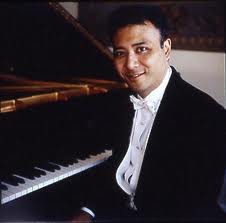|
Symphony
SRS SEASON ENDS WITH RESOUNDING TA-TA-TA-BANG
by Terry McNeill
Sunday, June 1, 2025
Symphony
YOUTHFUL VIRTUOSITY ON DISPLAY AT USO'S MAY CONCERTS
by Peter Lert
Saturday, May 17, 2025
Symphony
MYSTICAL PLANETS AND LIVELY GERSHWIN ORTIZ AT FINAL SRS CONCERT
by Peter Lert
Sunday, May 4, 2025
Symphony
VSO'S CONCERT MUSIC OF TIME, MUSIC OF PLACE
by Peter Lert
Sunday, April 27, 2025
Choral and Vocal
VOCAL ELEGANCE AND FIRE AT THE 222'S RECITAL APRIL 26
by Pamela Hicks Gailey
Saturday, April 26, 2025
CANTIAMO SONOMA SINGS AN INSPIRED GOOD FRIDAY MOZART REQUIEM CONCERT
by Pamela Hicks Gailey
Friday, April 18, 2025
DRAMATIC SHOSTAKOVICH SYMPHONY CLOSES PHILHARMONIC'S 25TH SEASON
by Terry McNeill
Sunday, April 13, 2025
LARGE COLLEGE OF MARIN AUDIENCE GREETS STOPHER ARTISTRY
by Terry McNeill
Saturday, April 5, 2025
Chamber
FRISSON DELIVERS SHIVERS OF DELIGHT
by Abby Wasserman
Sunday, March 30, 2025
OLD AND MOSTLY NEW IN SRS MARCH CONCERT IN WEILL
by Peter Lert
Saturday, March 22, 2025
|
 |
 Pianist Jon Nakamatsu |
JONNY COMES DANCING HOME IN MILL VALLEY RECITAL
by John Boyajy
Sunday, January 13, 2013
If you love Schumann's piano music, you would have been delighted with Jon Nakamatsuís Jan. 13 recital in Marin's Mt. Tamalpais Methodist Church, produced by the Mill Valley Chamber Music Society. For, although Schubert and Beethoven also were on the program, this recital was all about Schumann.
Schumannís life was turbulent and, like his contemporary Chopin, the drama and pathos he experienced in his personal life found its way into his compositions. Carnaval, Op. 9, is a monument in the Romantic piano literature and depicts in a series of 22 pieces sundry revelers at a festive ball. Fictional characters, many influenced by the Italian Commedia dellíArte such as Harlequin, Colombine and Pierrot, rub shoulders with Chopin, Paganini, and Schumannís depiction of his own two divergent personas: Florestan, the extrovert; and Eusebius, the dreamy introvert.
A fantastic and extensive journey, Carnaval runs the better part of a half-hour, and holding the work together is a challenge. Mr. Nakamatsu's tempos, colors, passion, poetry and overall sense of timing made this feel like the shortest Carnaval ever. Every phrase had life. The Prestos were very fast but never rushed or muddy. The pedaling was always perfect, with judicious use of the soft pedal to create a wide spectrum of colors. The double-fortes were sonorous and big Ė at times even a touch edgy Ė without ever being unpleasantly percussive. Here, as in the recital's Papillons, Op. 2, the dance movements were gems, blessed with perfect tempos and, where appropriate, some Viennese lilt. Mr. Nakamatsu uses his abundant musical imagination to bring out inner voices, especially in the repeats, which render his performances consistently interesting.
Carnavalís technical challenges are notorious. Yet, even when the listener was aware of the skill required to execute legato and staccato in one hand (as in Reconnaissance), negotiate lightning-quick leaps (Paganini), control repeated chords at soft volume, and execute fast, clean octaves, it was always apparent that this was a formidible technique being used in service to the music.
Mr. Nakamatsu offered concise and informative verbal commentary about both Schumann pieces. He set the audience up with great success, as many found themselves giggling at the appropriate moments.
Although shorter than Carnaval, Papillons (from 1829, 12 dance movements) is equally difficult to hold together, with some of the sections being barely more than musical snippets. Yet here, as throughout the recital, Mr. Nakamatsu kept the music moving forward and effectively unified Schumannís vignettes.
Two of Schubertís Opus 90 Impromptus opened the program: the third in G-Flat Major and the second in E-Flat, both deservedly well-known. The well-paced second Impromptu demonstrated perfect finger technique, and the brilliant coda was passionate and dramatic.
The G-Flat is known for its beautiful melody (Schubertís stock in trade) and challenges the pianist to play melody and accompaniment in the same hand, a gauntlet thrown down by many Romantic composers. Mr. Nakamatsu chose not to tone down the accompanying sextuplets in the right hand as much as other pianists might, thus creating an interesting (some might say controversial) conversation between the voices. The sound in the melody line was always beautiful, albeit neither velvety nor lush.
Beethovenís most famous sonata, the C-Sharp Minor of Op. 27 (Moonlight) ended the first half. In the slow opening movement, Mr. Nakamatsu chose a faster-than-usual tempo. As in the Schubert G-Flat Impromptu, the melody and accompaniment did not differ as much in volume as one often hears. In addition, the pianist treated the accompanying triplets to a particular kind of rubato that occasionally left this reviewer unsettled. The second movement was truly gracious and the last, played at whirlwind speed, abounded in intensity, dynamic contrast, verve and drama.
In his only encore, Chopinís popular Fantaisie-Impromptu in C Sharp, Op. 66, Mr. Nakamatsu imbued his performance with large doses both of tempo variation and ryhthmic variance. Indeed, the amount of rhythmic freedom in his rendition brought back memories of the great Romantic pianists of the early 20th century. And the whispering pianississimo at the end of the middle section was breathtaking. Here is a pianist who can emote without gushing.
The artist, who resides in San Jose, had an unqualified success before a full house and brought Schumann's exalted dances home with consummate mastery.
|
